City Lore Announces Landmark One of a Kind Exhibition
The Calling: The Transformative Power of African American Doll and Puppet Making
October 6th, 2023 – March 2, 2024

Celebrating senior visual storytellers who chronicle the history, identity and culture of their communities
October 6, 2023 – March 2, 2024
Curator Camila Bryce-Laporte & Consulting Scholar Phyllis May-Machunda
*Exhibit Includes Children’s Corner, Public Programs & Workshops. Visit our Calendar for upcoming events.
City Lore, an Affiliate of the Smithsonian Institution and a pioneer in Urban Folklore programming is pleased to announce the launch of a new exhibition entitled, The Calling: The Transformative Power of African American Doll and Puppet Making.
“The Calling: The Transformative Power of African American Doll and Puppet Making,” is conceived and curated by Camila Bryce-Laporte, (a noted doll maker herself) in partnership with scholar Phyllis M. Machunda. This exhibition includes dolls and puppets created by a group of 26 nationally acclaimed multi-media artists from the African Diaspora, who came of age in communities in the United States during the height of the Civil Rights and Black Arts Movements. Using mixed media, these visual storytellers chronicle the history, identity, and culture of their communities. Compelled or “called” to continue the special and enduring tradition of Black doll making, these artists recognize that their works are healing and transformative for themselves and for the communities they represent.
Organized into historic themes, the site-specific installation, also contextualizes the art as well as the art makers themselves, and includes videotaped conversations with the artists about their personal histories, the communities from which they emerged, their creative processes, and the transformative and spiritual power of their creations. The exhibition is appropriate for all ages and is supported by public programs, workshops, and a market day and is .
The exhibition is one of the inaugural projects of City Lore’s Cultural Ambassadors Residency Program, supported by the Institute for Library and Museum Services (ILMS).
“Rich with symbolism, all the artists have stories to tell, “ said Bryce-Laporte. “Each one of the 26 artists in the show was asked to create work that weaves a 400-year legacy into a multi-layered tapestry of expression.”Furthermore, as a group these artists defy the conventional
notion of dolls and puppets. We use our gifts and create as the spirit leads us.”
“City Lore,” says Founding Director Steve Zeitlin, shares curator Camila Bryce Laporte’s deep interest in African American history and culture. The Calling, an exhibit about Black dolls made by hand, with needle and thread, the softness of cloth, and the playfulness of puppetry, speaks to City Lore’s abiding passion for the art of everyday life.”
Participating Artists include: Kibibi Ajanku, Kay Williams Anderson, Judy Boldon Bain, Diana Baird N’Diaye, James Brown, Jr., Camila Bryce-Laporte, Karen Y. Buster, Kimberly Camp, Schroeder Cherry, Tracey Marlené Connor (photographer), IBé Crawley, Gloria Gammage Davis, Julee Dickerson-Thompson, Shimoda Donna Emanuel, Laura R. Gadson, Francine Haskins, Geraldine “Jeri” Hubbard, Ingrid Humphrey, Aundra McCoy, Sehar Peerzada, Paulette Richards, Elaine Robnett Moore, Imani W. Russell, Yolanda Sampson, Cynthia Sands, and Paula Whaley.
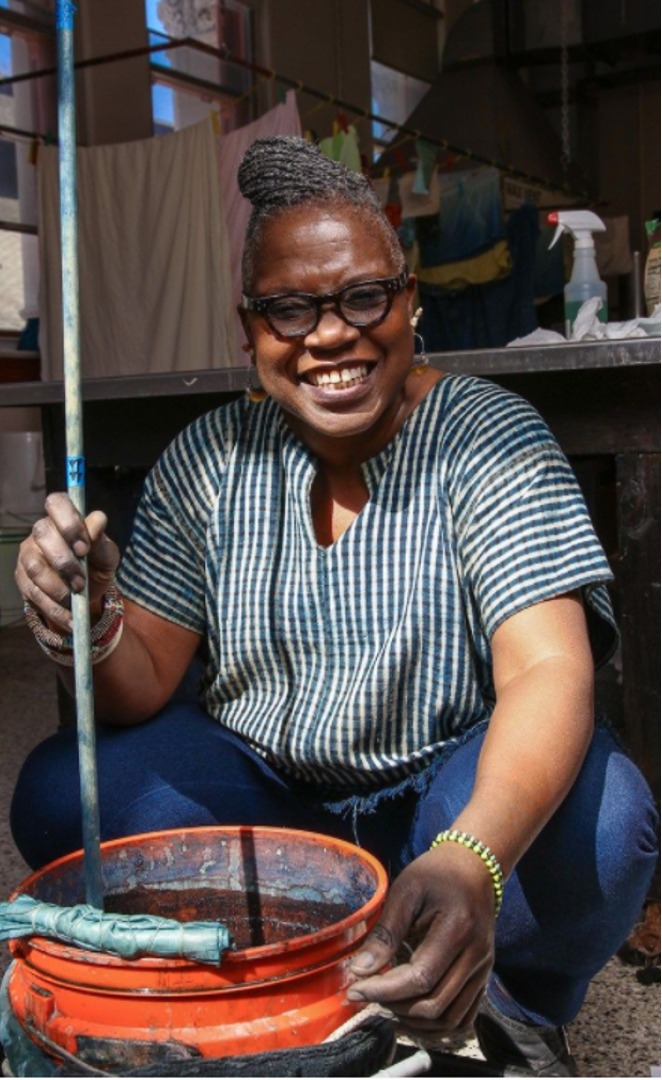
Baltimore native, Kibibi Ajanku attended Morgan State University and received her MFA in Curatorial Practice from Maryland Institute College of Art. She is Bearman Gallery Curator-In-Residence for the Frederick Douglass-Isaac Myers Museum in Baltimore, Maryland, founder of the Baltimore-based Sankofa Dance Theater, the Urban Arts Professor at Coppin State University, and Resident Artist/Researcher for Maryland Institute College of Art Fibers Department as well as the Equity and Inclusion Director of the Urban Arts Leadership Initiative for the Greater Baltimore Cultural Alliance. Ajanku makes and presents ethnically charged art that embodies the thrust of the African Diaspora. Ajanku’s artistry is layered with indigenous folkways because her muscle as a visual artist, spans from contemporary fine art to village inspired craft. Ajanku is empowered by international engagement, and she has traveled the African diaspora to study, teach, and work with many textile masters. Working in mixed media, Ajanku has exhibited nationally and internationally.
Artist Statement
My work embodies research, identity, and the gathering of elements of African retention. It reaches back into ancestral histories and stories that impact the world today.
 Kay Williams Anderson, a DC native, is a living legend in the esteemed Stewart Family and possesses exceptional artistic and spiritual talents. Her body of work has garnered universal admiration, establishing her as a revered figure in the art world. Kay’s military background instilled discipline and high standards, which shaped her artistry. She mastered trompe l’oeil and created captivating murals, showcasing her dedication and determination. Kay’s exploration of dolls, including the iconic giant Fat Albert doll, revealed her meticulous attention to detail and unique genius. Inspired by Black American heroes, she crafted 24″ dolls, triumphing over creative obstacles. Kay’s indomitable spirit breathes life into stocking dolls, creating original narratives. Her innovative art transcends time, captivating hearts worldwide.
Kay Williams Anderson, a DC native, is a living legend in the esteemed Stewart Family and possesses exceptional artistic and spiritual talents. Her body of work has garnered universal admiration, establishing her as a revered figure in the art world. Kay’s military background instilled discipline and high standards, which shaped her artistry. She mastered trompe l’oeil and created captivating murals, showcasing her dedication and determination. Kay’s exploration of dolls, including the iconic giant Fat Albert doll, revealed her meticulous attention to detail and unique genius. Inspired by Black American heroes, she crafted 24″ dolls, triumphing over creative obstacles. Kay’s indomitable spirit breathes life into stocking dolls, creating original narratives. Her innovative art transcends time, captivating hearts worldwide.
Artist Statement
I tell the history of Black American heroes through making contemporary Black American dolls of underrepresented figures (ballerinas, divas, artists).
 Born in Trinidad, Judy Boldon Bain attended Tranquility Girls’ School and on graduation entered Port of Spain General Hospital’s School of Nursing, where she became a registered nurse. She then attended McGill University to become an occupational therapist.
Born in Trinidad, Judy Boldon Bain attended Tranquility Girls’ School and on graduation entered Port of Spain General Hospital’s School of Nursing, where she became a registered nurse. She then attended McGill University to become an occupational therapist.
One of the rehabilitation processes in Occupational Therapy is basketry. In 1983, Boldon Bain relocated to the US Virgin Islands. Here her involvement in basketry moved from a therapeutic to an artistic phase. Making her first doll in 1990, she later taught the method of weaving the dolls in St. Croix and to Trinidadian villagers. Her innovative dolls have been enthusiastically received and purchased internationally.
Artist Statement
I never had a doll growing up. I felt [these figures] were so much a part of the culture of Trinidad and Tobago. A lot of [these figures] came from where we came from in the African continent. The old Africans in my community in the olden days, saved every cent that they had to create these characters. People have now taken carnival to the point where it is just music and dance in the street. I want them to return to the traditional carnival. [Dollmaking] is something that I need to do to bring my people back . . . . My dolls are not for playing with. They are for teaching young people about their African heritage and the early days of carnival.
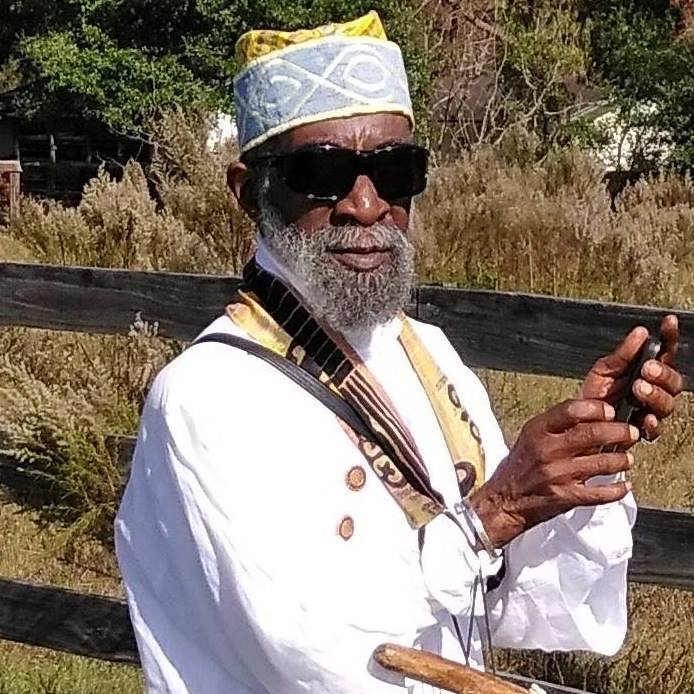 Born in Harlem in James Brown, Jr. to a family who had migrated from Florida during the Depression. Brown began drawing and painting by the age of four and began his art education at the Art Students League (then School of Visuals) in Manhattan during the 1960’s. He earned a BA in Fine Arts from University of South Florida, and an MFA from Howard University. After graduate school, Brown drastically changed his creative processes and shifted from watercolor painting to working with textile/fibers, a medium with which he was very familiar. Both of his parents had worked with textiles, from upholstery fabrics to lace and silks. Brown uses a variety of techniques including stitching, embroidery, silk painting, appliquéing strips, and felting–both wet and needle. Now living in Washington, D.C., Brown has been a mentor to several doll artists in this show and his work has been exhibited at the Smithsonian and collected locally and nationally.
Born in Harlem in James Brown, Jr. to a family who had migrated from Florida during the Depression. Brown began drawing and painting by the age of four and began his art education at the Art Students League (then School of Visuals) in Manhattan during the 1960’s. He earned a BA in Fine Arts from University of South Florida, and an MFA from Howard University. After graduate school, Brown drastically changed his creative processes and shifted from watercolor painting to working with textile/fibers, a medium with which he was very familiar. Both of his parents had worked with textiles, from upholstery fabrics to lace and silks. Brown uses a variety of techniques including stitching, embroidery, silk painting, appliquéing strips, and felting–both wet and needle. Now living in Washington, D.C., Brown has been a mentor to several doll artists in this show and his work has been exhibited at the Smithsonian and collected locally and nationally.
Artist Statement
The artistic images I have produced over fifty years and counting, represent an accumulation of the history I lived through, cultures I experienced, and wisdom I accumulated. I am a spiritual being and a traditionalist connected to the universe. All my work is done by hand. My dreams play a tremendous part influencing the completion of my works.

Camila Bryce-Laporte is a doll artist and curator of this exhibition on African American dolls and puppets. Her academic journey in the arts and humanities, with a specialization in folklore from Sarah Lawrence College and George Washington University, has spanned over 40 years. During this time, she has dedicated herself to researching and developing cultural programming as a folklife specialist and community scholar for esteemed institutions such as the Smithsonian Institution and The Library of Congress. Her focus has been on researching the expressive cultures of various cultural groups, including traditions of the African Diaspora in the Mid-Atlantic, and the intersection of diverse immigrant communities in the Chesapeake region. Bryce-Laporte has been the principal coordinator or curator for several programs on the African American doll tradition.
Artist Statement
My work is inspired by Black and Indigenous women like my own ancestors who are often overlooked or eliminated from the historical text but have made significant contributions to the social and cultural development of the Americas.
 A native of Baltimore, MD., Karen Y. Buster is an artist who works with an x-acto knife, steel, and wood. Raised in an artistic family, she was encouraged to develop her creativity and to recognize that her gift came from a Higher Power. At age 18, she started her first business “Bustertizin”, as a t-shirt designer while a student in New Orleans. She earned a Bachelor of Arts degree in Business Administration from Dillard University, and is also a proud member of Delta Sigma Theta Sorority, Incorporated. She transitioned from designing and printing t-shirts to working with an x-acto knife, steel, and wood to make art accessible to the masses through direct participation in community art exhibits and cultural festivals. Her award winning work has been featured in TV, film, and in national collections.
A native of Baltimore, MD., Karen Y. Buster is an artist who works with an x-acto knife, steel, and wood. Raised in an artistic family, she was encouraged to develop her creativity and to recognize that her gift came from a Higher Power. At age 18, she started her first business “Bustertizin”, as a t-shirt designer while a student in New Orleans. She earned a Bachelor of Arts degree in Business Administration from Dillard University, and is also a proud member of Delta Sigma Theta Sorority, Incorporated. She transitioned from designing and printing t-shirts to working with an x-acto knife, steel, and wood to make art accessible to the masses through direct participation in community art exhibits and cultural festivals. Her award winning work has been featured in TV, film, and in national collections.
Artist Statement
My work has been described as irregular, eccentric, different, unusual, and unconventional. I will continue to look at everyday images in this unorthodox way. Art has allowed me to speak feelings that can’t always be said through words. I hope I can inspire young people to know that art has a voice. . . . Art is not what I see…but what I make others see. — Karen Y. Buster
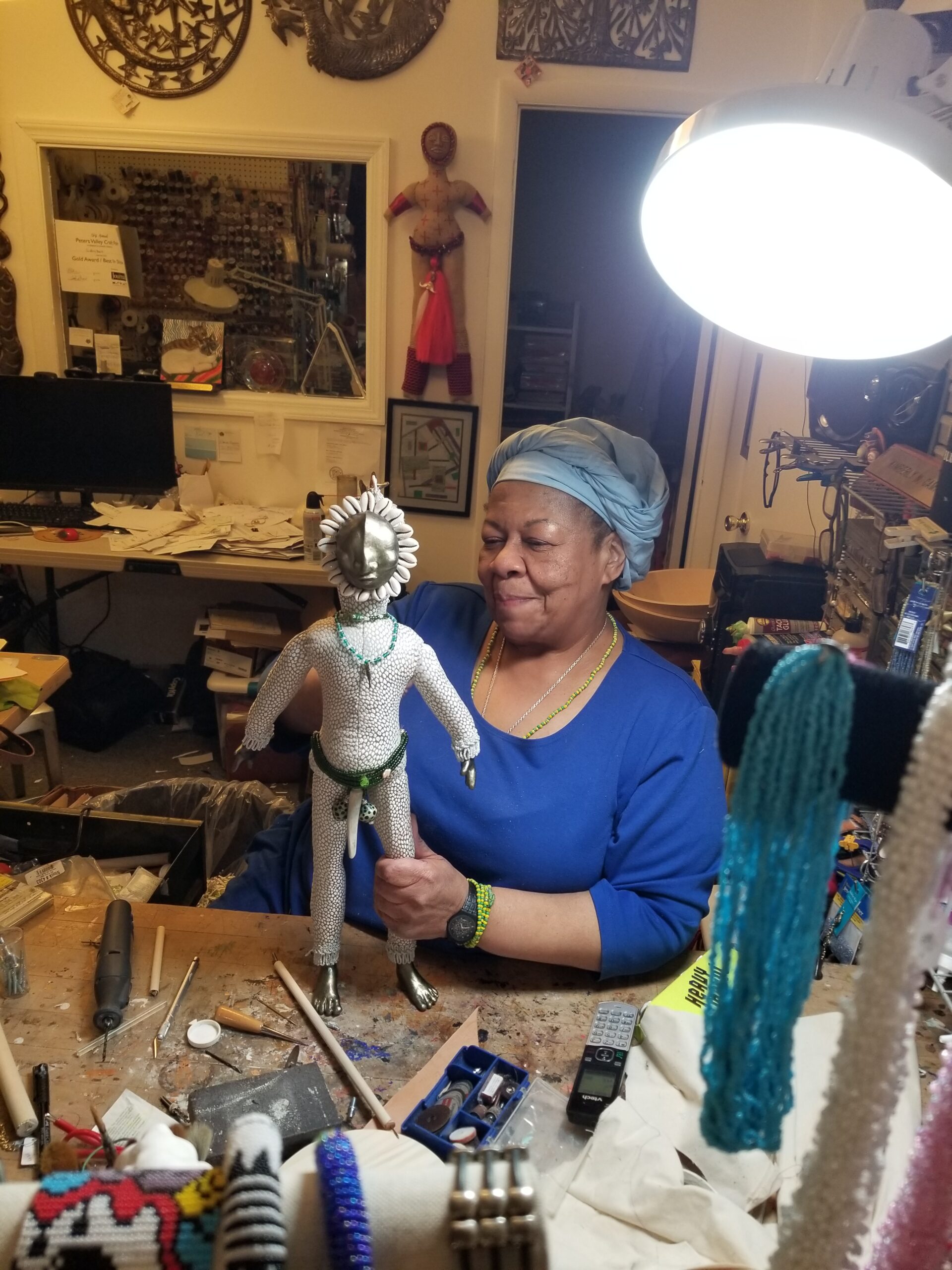
Kimberly Camp, a doll artist who is a native of Camden, NJ, received her Bachelor of Arts degree from the University of Pittsburgh and her Master of Science degree from Drexel University. She pursued a dual career as a painter and doll artist as well as an arts administrator, serving as president and CEO of The Barnes Foundation, founding director of the Smithsonian Institution Experimental Gallery, and president and CEO of the Charles Wright Museum in Detroit during her career.
In 1982, Camp began making Brown Babies, later renamed Kimkins, using hand-dyed cotton and African textiles, to represent western, central, and eastern African ethnic groups. Camp began making one-of-a-kind dolls in 1989, using materials from world cultures to craft dolls with layered significance. Her construction materials include leather, raffia, animal teeth, horn, textiles, beads, and cowrie shells. Her dolls have appeared in multiple national and international exhibits, publications, and videos. Camp fulfilled a life-long dream and is owner and president of her own gallery, Galerie Marie in Collingwood, New Jersey.
Artist Statement
My work is centered around family, including my ancestors, whose guidance and protection surround me at all times. Some of my work depicts actual family members and attempts to capture the moments that all families know – that of the embrace or warmth of sisters proudly standing together, or nieces and uncles horsing around. Others combine those images with glimpses of the ancestors, and their subtle or not so subtle conversations about their embrace of the living. Other work draws only from the spiritual plane, with manifestations of guardians, protectors, tricksters, and other entities who appear without forethought in the act of painting. Sometimes they reflect specific spiritual traditions from family roots, and others combine African and American traditions in ways that capture the essence of our African American ancestry.
 Originally from Washington, D.C., Dr. Schroeder Cherry is an award-winning, Maryland-based artist and puppeteer, who captures everyday scenes of life in the African Diaspora. He earned a BFA in painting and puppetry from The University of Michigan; a master’s degree in museum education from George Washington University; and a doctorate in museum education from Columbia University. His works are in private and public collections across the US. Cherry is currently Curator at The James E. Lewis Museum of Art (JELMA), Morgan State University.
Originally from Washington, D.C., Dr. Schroeder Cherry is an award-winning, Maryland-based artist and puppeteer, who captures everyday scenes of life in the African Diaspora. He earned a BFA in painting and puppetry from The University of Michigan; a master’s degree in museum education from George Washington University; and a doctorate in museum education from Columbia University. His works are in private and public collections across the US. Cherry is currently Curator at The James E. Lewis Museum of Art (JELMA), Morgan State University.
Artist Statement
There is an inventiveness to Black culture that we value. Creativity and having to “make do” is a hallmark of African American culture. . . . I use storytelling to do deep, non-apologetic dives into African American culture. I address contemporary issues with humor. I believe one of the important tenets of African cultures retained by their American descendants is the narrative, the storytelling that is incorporated in dolls and puppets.
 Tracey Marlene Connor is a native New Yorker, currently residing in Bowie, Maryland. She holds a Bachelor of Arts in Forensic Psychology from John Jay College of Criminal Justice, New York, NY. However, she feels she received her most important education from her father, “a chef, a dancer, a D.I.Y genius, and a storyteller.” After becoming a Forensic Document Examiner, she knew she was called to become more and self-taught, she has spent over 20 years freelancing website and graphic design projects. She later earned a Digital Arts Profession Certification from Sessions College for Professional Design, developed a passion as a photographer and opened her own business, Tracey MarLené Media. She is an active member of Professional Photographers of America.
Tracey Marlene Connor is a native New Yorker, currently residing in Bowie, Maryland. She holds a Bachelor of Arts in Forensic Psychology from John Jay College of Criminal Justice, New York, NY. However, she feels she received her most important education from her father, “a chef, a dancer, a D.I.Y genius, and a storyteller.” After becoming a Forensic Document Examiner, she knew she was called to become more and self-taught, she has spent over 20 years freelancing website and graphic design projects. She later earned a Digital Arts Profession Certification from Sessions College for Professional Design, developed a passion as a photographer and opened her own business, Tracey MarLené Media. She is an active member of Professional Photographers of America.
Artist Statement
I was born and raised in Harlem, New York. It was impossible to have lived on 153rd Street and 8th Avenue and not be bred as a creative. Harlem was bursting with talent! We sang, we danced, we constantly created something from our souls! It was in that spirit, I would find a way to survive the School of Hard Knocks. I learned how to grow from the pain, and most importantly, I realized the refuge in storytelling, in being a creative, and embracing my roots. When I honored the Artist in Me, I realized my call.

IBé Bulinda Crawley is an educator, storyteller and a self-taught visual artist. She received a BA in English and a Masters in Education from Virginia Commonwealth University, and further leadership training at George Mason University, while employed in the Fairfax County Public Schools. Her studio at IBe’ Arts Institute in Hopewell Virginia, is housed in an1830 school that she renovated, and is a sanctuary for marble, clay, and collage work. Whether making paper for a book project or hand-stitching a ‘QD’- quilt doll, she views the sculptural form as her most creative medium, using a diverse array of materials such as cotton, wax, paper, stone, and wood. Her artist books are included in university, museum, and private collections across the United States and in Britain.
Artist Statement
My experience teaching American history motivates me to research and present the black female perspective and to create visual representations of Black womanhood. My works are monuments to the determination of Black women to survive, i.e. keep family and community together. I grew up in the cotton and tobacco town of Danville, Virginia, surrounded by strong and determined women. In addition, the influences of my grandfather’s Civil Rights leadership, my mother’s disabilities, and my grandmother’s church leadership are the childhood experiences that form my approach to living a resilient life. The sacred dwellings of black people in the American south, the significance of water and soil, ‘making do’ with found objects, and maternal spirits are recurring themes in my work.

Gloria Gammage Davis expresses her calling as an assemblage artist, doll maker, art quilter, sculptor, painter, jewelry designer and educator. She earned her BFA from Cheyney University with full honors. She is now an established artist who has exhibited her artistry in galleries and museums nationally and taught art skills to both children and adults. Davis was born in a southern town where the old wooden train station, next to the new one, still had a vintage sign over the drinking fountain saying, “whites only”. It was under that backdrop that she inherited her father’s talent for art and the value of her culture. While living with two aunts who were seamstresses, one aunt, recognizing her interest, tore up a doll dress that she had hand sown in order to teach her how to sew. Gloria Gammage Davis is featured in the quilting books, We Are the Story (2021) and Black Pioneer Legacy in the American West (2022) by Carolyn Mazloomi.
Artist’s Statement
I created “Hands Up” because George Floyd’s brutal death was emotional for me and called attention to police brutality. I felt he could have been a member of my family and it was personal. . . It harkens back to what our ancestors endured. . . . The call is to continue to keep this issue in the forefront and to challenge the establishment to make significant changes.

Julee Dickerson-Thompson is an award-winning artist and D.C. native, who was nurtured in the Smithsonian museums, and the Workshops for Careers in the Arts (now, Duke Ellington School of the Arts)–arts institutions in her backyard. She continued her studies at Simmons University, Massachusetts College of Art, the School of the Museum of Fine Arts Boston, and the Corcoran College of Art. All her works integrate influences from her experiences in West Africa, the Caribbean, and France, through experimentation with mixed media, soft sculpture, quilts and dollmaking. Her work is featured in exhibits, collections, galleries, museums, and “alternative spaces” nationally and internationally.
Artist Statement
In 1978 I made my first doll. The next year, my first child (daughter) was born, and my mother, Ann Dickerson, collaborated with me to start Brown Spice dolls, which developed into Young Masters, Inc. Regardless of the medium I work in, I incorporate themes of Womanism, peace, progressive concerns, deep spiritual symbolism, and intergenerational relationships and community. I know the power of art, and seek to use it to uplift, heal, and change people’s minds and hearts into action.

Second Generation visual artist Laura R. Gadson explores and blends mediums, techniques, and materials based in her love of textiles, paper, glass and other materials. She is a graduate of the renowned Fiorello LaGuardia High School of Music and Art and holds a BFA from the City College of New York. Her work has been widely exhibited, reproduced as public art in her community, and is proudly part of various public and notable private collections, including the Schomburg Center for Research in Black Culture. Since 1993, she has lived and created in a brownstone in Harlem, New York.
Artist Statement
I consider myself a lifelong learner and cultural Griot who seeks to celebrate legacy, preserve history, and illuminate ideologies in my creative work. Through vibrant and expressive imagery, I have the ability to share discoveries, tell stories, communicate thoughts, and uplift the spirit. Although I enjoy working in a variety of mediums and discovering new ones, I always return to my first loves of fabric and fiber. Being gifted with creativity is truly a blessing that I am privileged to share with others.

Harlem-based Shimoda Donna Emanuel has received widespread recognition for wide range of creative works. Her work has graced the covers of prestigious publications like Essence, and her dolls have been exhibited on a national level. In addition to her visual artistry, Shimoda is an author who works creatively to give caretakers an opportunity to care for themselves. She is also a poet and author, with several books to her name. www.Shimoda-accessories.com “Sacred Stitches – Fiber for the Soul” by Shimoda Donna Emanuel
“My dolls are a reflection of my connection to the inner spirit. I believe beauty on the
inside has to reflect on the outside.”

Francine Haskins was born in Washington, DC and a graduate of McKinley Tech, where she studied art with master artist, Sam Gilliam. After beginning as a graphic artist, she has evolved into a celebrated mix-media fiber artist, doll maker, quilter, author/illustrator, teacher, and storyteller. Francine graduated from the Corcoran School of Art (Advertising Design) and trained at Catholic University in oil painting and the Smithsonian Associate Program in fabric design. Haskins is renowned for her quilts, her soft sculpture dolls, note cards, wearable art and her children’s books. Her creations are sold in the National Museum of African American History and Culture and other international venues.
Artist Statement
For me a black doll isn’t just a white doll painted brown. They have personalities that speak to people. Black children need to see a reflection of themselves. When you see yourself, you know you are worth something. When you see yourself, then you can become yourself.
 Geraldine (Jeri) Hubbard was born into family led by skilled artisans who valued education. Her father, Friendloyd Hubbard, was a chef. Her mother, Fannie Fitzgerald Hubbard, was a talented seamstress and quilter, who taught Jeri how to sew at an early age. Jeri’s early passion for sewing was matched by her life-long love of fine arts.
Geraldine (Jeri) Hubbard was born into family led by skilled artisans who valued education. Her father, Friendloyd Hubbard, was a chef. Her mother, Fannie Fitzgerald Hubbard, was a talented seamstress and quilter, who taught Jeri how to sew at an early age. Jeri’s early passion for sewing was matched by her life-long love of fine arts.
Jeri made dolls for several decades. She worked the Black doll circuit in the 1980s and 1990s, where she forged relationships with other artists and collectors who understood the importance of her work and encouraged her professional development. Designer Anthony Haskins introduced her to Butterick Publishing Co. that published her doll patterns. Doll artist and close friend, Francine Haskins, encouraged Jeri to move away from the machine and sew her art dolls by hand. Francine’s advice changed both her execution and relationship with the art form.
Each of Jeri’s dolls is a spiritually grounded, exquisite work of art. As she prepared to make a doll, she prayed for God’s wisdom and guidance, and for God to cover her hands, heart, and soul. Her dolls are well-crafted with small fine stitching and meticulous details.
Jeri has supported ambitious ventures in the Black doll community. She befriended collector Barbara Whitman and for many years she participated in programs at Barbara Whitman’s Philadelphia Doll Museum. In the 1980s, she was among the first artists to participate in the William Grant Still Center’s Black Doll Show in Los Angeles. This show, inspired by Kenneth and Mamie Clark’s Black doll test, was created to uplift the self-esteem of Black children.
As an artist and educator dedicated to this objective, Jeri’s dolls were inspired by historical figures, significant events, or her personal journey. Jeri’s signature doll collections include “Black Women Development,” which celebrates the achievement of women like Josephine Baker, Harriet Tubman, and Toni Morrison; and “Black Lives Matter,” a collection initially inspired by the acquittal of George Zimmerman in the killing of Trevon Martin. Jeri stated, “I want Black children to be knowledgeable [about their history]. I want Black children to accept themselves as Black people.”
Jeri Hubbard’s artwork has been exhibited nationally, including the Library of Congress and the Philadelphia Doll Museum.
Artist Statement
I want Black children to be knowledgeable [about their history]. I want Black children to accept themselves as Black people.
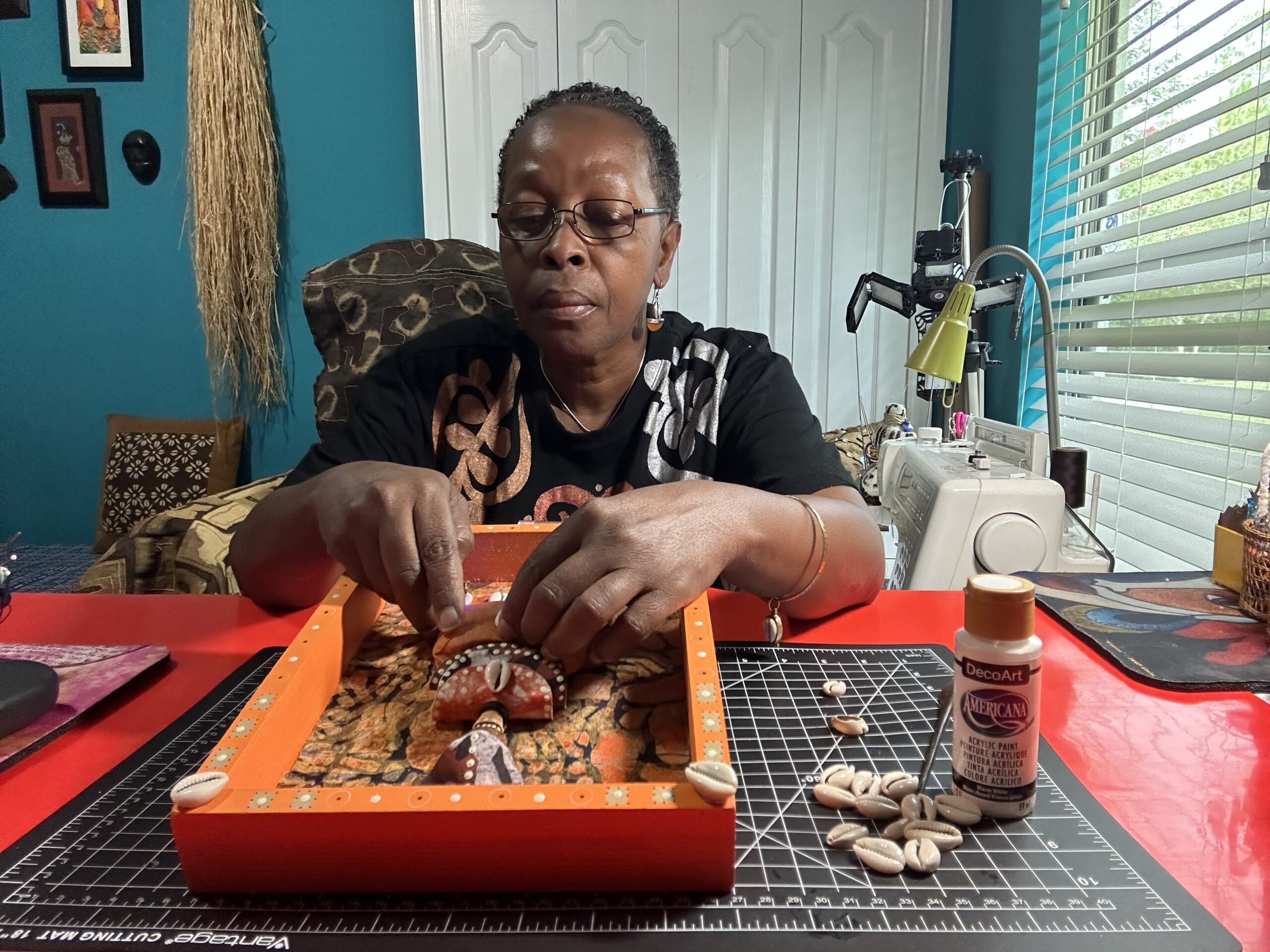 Ingrid Humphrey, a Florida native, reluctantly learned to sew at age 9 from her grandmother, a professional seamstress. Many years later, Humphrey was called to make dolls as she was recovering from a head injury. She began to make African American art dolls when she noticed the lack of availability and to make herself happy as she recovered. Ingrid Humphrey also has made dolls for the Dolls of Hope Project, launched by Dr. Cynthia Davis, more than two decades ago. The Dolls of Hope Project has distributed several thousand handmade cloth dolls to orphans, women, and youth affected by HIV/AIDS throughout the world. Humphrey’s work has also been exhibited nationally.
Ingrid Humphrey, a Florida native, reluctantly learned to sew at age 9 from her grandmother, a professional seamstress. Many years later, Humphrey was called to make dolls as she was recovering from a head injury. She began to make African American art dolls when she noticed the lack of availability and to make herself happy as she recovered. Ingrid Humphrey also has made dolls for the Dolls of Hope Project, launched by Dr. Cynthia Davis, more than two decades ago. The Dolls of Hope Project has distributed several thousand handmade cloth dolls to orphans, women, and youth affected by HIV/AIDS throughout the world. Humphrey’s work has also been exhibited nationally.
Artist Statement
[Some of my dolls] are designed as a reflection of my personality. My grandmother used to often tell me that still waters run deep. I didn’t understand it at the time but as I experienced life, I began to understand. Whenever I’m experiencing the uncertain times in my life, I retreat……I sit quietly beside the still waters internally, with prayer and thanksgiving, I meditate and set my focus above.
 Diana Baird N’Diaye, Ph. D., is an interdisciplinary visual artist/maker, and folklore scholar. Her artwork, research, and writing reference sacred expressions of identity across Africa and the Diaspora. As a Fellow of the American Folklore Society, and Senior Curator and Cultural Specialist at the Smithsonian’s Center for Folklife and Cultural Heritage, she developed and leads The African American Craft Initiative, a project for which she was recognized in 2022 as a Crafts Visionary by the American Crafts Council. Her participatory craft research projects include The Will to Adorn: African American Dress and the Aesthetics of Identity, subject of an upcoming book (2024), and The Crafts of African Fashion, featured at the 2018 Smithsonian Folklife Festival. She maintains an active studio practice working primarily in textiles. Her artwork resides in both public and private collections.
Diana Baird N’Diaye, Ph. D., is an interdisciplinary visual artist/maker, and folklore scholar. Her artwork, research, and writing reference sacred expressions of identity across Africa and the Diaspora. As a Fellow of the American Folklore Society, and Senior Curator and Cultural Specialist at the Smithsonian’s Center for Folklife and Cultural Heritage, she developed and leads The African American Craft Initiative, a project for which she was recognized in 2022 as a Crafts Visionary by the American Crafts Council. Her participatory craft research projects include The Will to Adorn: African American Dress and the Aesthetics of Identity, subject of an upcoming book (2024), and The Crafts of African Fashion, featured at the 2018 Smithsonian Folklife Festival. She maintains an active studio practice working primarily in textiles. Her artwork resides in both public and private collections.
Artist statement:
Through cloth—quilted, and otherwise shaped, embroidered, and embellished, I am called to tell visual stories about identity and heritage, retold pasts, and aspirational futures.
Through my work, I honor and explore relationships between these personal and global histories.
 Sehar Peerzada creates “Urban Masala”, wearable art clothing, home goods, and dolls. Born in Washington DC, Peerzada works from her home studios in Baltimore, MD and Lahore, Pakistan. An alumnus of Howard University and the Rhode Island School of Design, Peerzada studied Eastern design concepts and cuts, along with the ancient art of hand block printing in Pakistan. Her creations are influenced by traditional sources in Africa, Asia, Native America, and Europe. She often uses the ancient art of block printing using natural fibers. She collaborates with Pakistani artists to create her signature block designs which are incorporated in her own hybrid clothing and fabric. Controlling the placement, intensity, and content of the prints in her limited edition separates and ensembles, makes each piece a wearable art treasure. With leftover cloth, she began making Abayomi dolls. Now they are included in her collections.
Sehar Peerzada creates “Urban Masala”, wearable art clothing, home goods, and dolls. Born in Washington DC, Peerzada works from her home studios in Baltimore, MD and Lahore, Pakistan. An alumnus of Howard University and the Rhode Island School of Design, Peerzada studied Eastern design concepts and cuts, along with the ancient art of hand block printing in Pakistan. Her creations are influenced by traditional sources in Africa, Asia, Native America, and Europe. She often uses the ancient art of block printing using natural fibers. She collaborates with Pakistani artists to create her signature block designs which are incorporated in her own hybrid clothing and fabric. Controlling the placement, intensity, and content of the prints in her limited edition separates and ensembles, makes each piece a wearable art treasure. With leftover cloth, she began making Abayomi dolls. Now they are included in her collections.
Artist Statement
Abayomi–from the Yoruba words meaning precious meeting, brings joy. Captured African women tore pieces of their own clothing and using knots and strings, fashioned them into dolls that were given to their children for comfort. Today, they represent our lost ancestors and the retelling of their stories. Abayomi dolls bring joy to the receiver!”
 Independent researcher, Dr. Paulette Richards earned her Ph.D. from University of Virginia and has taught at Georgetown University, Tulane University, and Georgia Tech. During her time as a 2013/ 2014 Fulbright Scholar in Senegal, she began to focus her multi-disciplinary interest in African Diasporan cultural studies on puppets, masks, and performing objects. In 2018 she co-curated the Living Objects: African American Puppetry exhibit at the University of Connecticut’s Ballard Institute and Museum with Dr. John Bell. More recently she curated a traveling exhibit on The Wonderland Puppet Theater. Her book, Object Performance in the Black Atlantic: The United States is available from Routledge.
Independent researcher, Dr. Paulette Richards earned her Ph.D. from University of Virginia and has taught at Georgetown University, Tulane University, and Georgia Tech. During her time as a 2013/ 2014 Fulbright Scholar in Senegal, she began to focus her multi-disciplinary interest in African Diasporan cultural studies on puppets, masks, and performing objects. In 2018 she co-curated the Living Objects: African American Puppetry exhibit at the University of Connecticut’s Ballard Institute and Museum with Dr. John Bell. More recently she curated a traveling exhibit on The Wonderland Puppet Theater. Her book, Object Performance in the Black Atlantic: The United States is available from Routledge.
Artist Statement
African figurative sculpture and object performance were suppressed in the United States precisely because they challenged the objectification of African Americans as chattel slaves. Direct connections with the material practices of object performance in African societies were all but obliterated; however, the elements of African storytelling performance survived.
 Imani W. Russell is the creator of Indigo’s Friends Art Dolls and Notions and owner of Indigo’s Friends Studio in Brentwood, Maryland. She is a largely self-taught dollmaker, designer, and fiber artist drawing on influences from the arts of her mother and her maternal grandmother. Both created hand stitched utilitarian quilts and other wonderful things from worn clothing, found fabrics, and unusual objects. She began creating Indigo’s Friends cloth dolls in the early 1990s. The colors and textures of cloth lures, then permits her to manipulate and recreate a thing of wonderfulness; often manifesting decorative art dolls, wall collages, and utilitarian wares. Hand stitch after stitch, she endures until she achieves a rhythm that reveals the soul of the piece, then she weaves in found objects and contrasting textures. Her work is exhibited nationally.
Imani W. Russell is the creator of Indigo’s Friends Art Dolls and Notions and owner of Indigo’s Friends Studio in Brentwood, Maryland. She is a largely self-taught dollmaker, designer, and fiber artist drawing on influences from the arts of her mother and her maternal grandmother. Both created hand stitched utilitarian quilts and other wonderful things from worn clothing, found fabrics, and unusual objects. She began creating Indigo’s Friends cloth dolls in the early 1990s. The colors and textures of cloth lures, then permits her to manipulate and recreate a thing of wonderfulness; often manifesting decorative art dolls, wall collages, and utilitarian wares. Hand stitch after stitch, she endures until she achieves a rhythm that reveals the soul of the piece, then she weaves in found objects and contrasting textures. Her work is exhibited nationally.
Artist Statement
Childhood remembrances of summer visits to the homeland of my parents in the rural south and a fascination with my Gullah muse, Indigo, are the underpinning inspirations for my art creations. Barefoot on red dirt, blanketed cotton fields, ancestral history, and social issues influence my ideas of Beautiful Blackness. I compose sculptural figures, wall art, and utilitarian wares with reclaimed fabrics and found objects.
 Yolanda Sampson, earned a Master of Divinity degree from Fuller Theological Seminary and a B.A. from Howard University’s School of Communications. Presently, she is Director of Evangelism at First Church of Christ Holiness in Washington, D.C. and is founder and president of GO Y.O. Worldwide, LLC, a gospel puppet ministry company that educates and empowers elementary-aged children to live through their Christian faith. Sampson has performed message-oriented puppet shows and taught puppet making workshops nationally and internationally. She has served as National Capital Puppetry Guild President and was a featured puppeteer in The Living Objects: African American Puppetry Exhibition at the Ballard Institute and Museum of Puppetry.
Yolanda Sampson, earned a Master of Divinity degree from Fuller Theological Seminary and a B.A. from Howard University’s School of Communications. Presently, she is Director of Evangelism at First Church of Christ Holiness in Washington, D.C. and is founder and president of GO Y.O. Worldwide, LLC, a gospel puppet ministry company that educates and empowers elementary-aged children to live through their Christian faith. Sampson has performed message-oriented puppet shows and taught puppet making workshops nationally and internationally. She has served as National Capital Puppetry Guild President and was a featured puppeteer in The Living Objects: African American Puppetry Exhibition at the Ballard Institute and Museum of Puppetry.
Artist Statement — Rev. Yolanda Sampson, M. Div.
It is through these living crafts that we hope to convey this message to our children and those that follow them: “You carry within you a rich cultural heritage, and like these talented independent artists, the range of your creativity and possibility is unlimited.”
 Cynthia Sands spent her formative years in Washington, D.C. and graduated from Howard University’s School of Fine Art in 1971. She formally studied with and befriended several of the leading African and African American visual artists of the 20th and 21st centuries, who influenced her sense of color and concept. After college, she built a career as a textile artist, specializing in designing and exhibiting batiks. Her art career includes the creation of new dye and color applications, utilizing and experimenting with original methods and materials in Africa. While devoting 26 years of her life to living in multiple African countries, she has studied and documented the uses of African indigenous textiles in African life and researched the signs and symbols on indigenous textiles as an African peoples’ visual history. She has exhibited work nationally and internationally.
Cynthia Sands spent her formative years in Washington, D.C. and graduated from Howard University’s School of Fine Art in 1971. She formally studied with and befriended several of the leading African and African American visual artists of the 20th and 21st centuries, who influenced her sense of color and concept. After college, she built a career as a textile artist, specializing in designing and exhibiting batiks. Her art career includes the creation of new dye and color applications, utilizing and experimenting with original methods and materials in Africa. While devoting 26 years of her life to living in multiple African countries, she has studied and documented the uses of African indigenous textiles in African life and researched the signs and symbols on indigenous textiles as an African peoples’ visual history. She has exhibited work nationally and internationally.
Artist Statement
In an artistic collaboration with Ghanaian Carver Awuda, I created a series of finely designed, hand painted, and sculpted dolls inspired by the traditional West African Akuaba carvings and folklore to bring to life the wisdom of our African ancestors. I have [actually] taken somebody else’s form, reconstructed it and taken it to another dimension. Yet, the dolls are authentic to me because they come from a spiritual space that I recognize.
 Born in Harlem, Paula Whaley’s father, preacher David Baldwin, died on the day of her birth. That day, her 19-year-old brother, author James Baldwin, or Jimmy, as she called him, was thrust in the role of father and brother for his youngest sister and their seven siblings. As a child, Paula made paper dolls with fashionable clothing. Her brother, Jimmy, was the first to recognize and encourage her artistic talents. Whaley, a graduate of Fashion Institute of Technology, also studied at Cadres Couture, while living in with her brother in Europe.
Born in Harlem, Paula Whaley’s father, preacher David Baldwin, died on the day of her birth. That day, her 19-year-old brother, author James Baldwin, or Jimmy, as she called him, was thrust in the role of father and brother for his youngest sister and their seven siblings. As a child, Paula made paper dolls with fashionable clothing. Her brother, Jimmy, was the first to recognize and encourage her artistic talents. Whaley, a graduate of Fashion Institute of Technology, also studied at Cadres Couture, while living in with her brother in Europe.
Deep in profound grief at the death her brother in 1987, Whaley encountered a sculptor who, recognizing her inconsolable pain, urged that she direct her grief into working with clay. Whaley found transformative solace through creating figures with clay, stating, “Art can heal. Something hits you. It strikes you. That’s the power . . . The dolls saved me. The dolls kept me alive.” Her dolls are in national and international exhibitions and collections.
Artist Statement
“Oh, yes, I meditate, and I pray every day. It’s the first thing I do, and that’s what my mother did. It was a ritual. But every day, I do get up, I meditate, and I’m thankful for the gifts that I have been given. And I really spend a lot of time—because of the work that I’m doing, and want to continue—thanking my ancestors. I literally pray to my ancestors.” (Paula Whaley, HOUSE BEAUTIFUL, 2022)
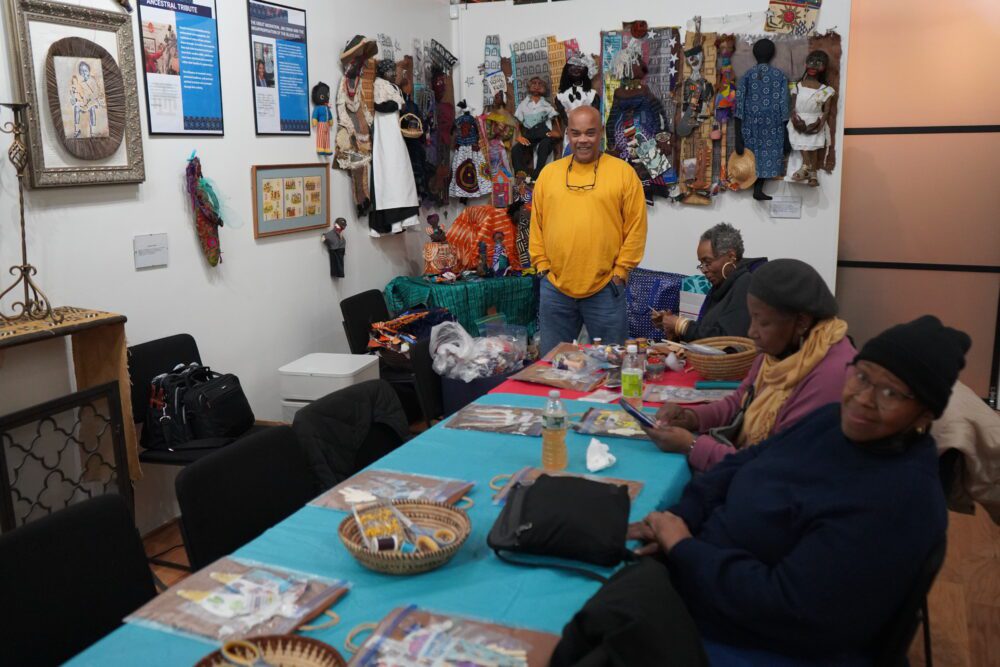
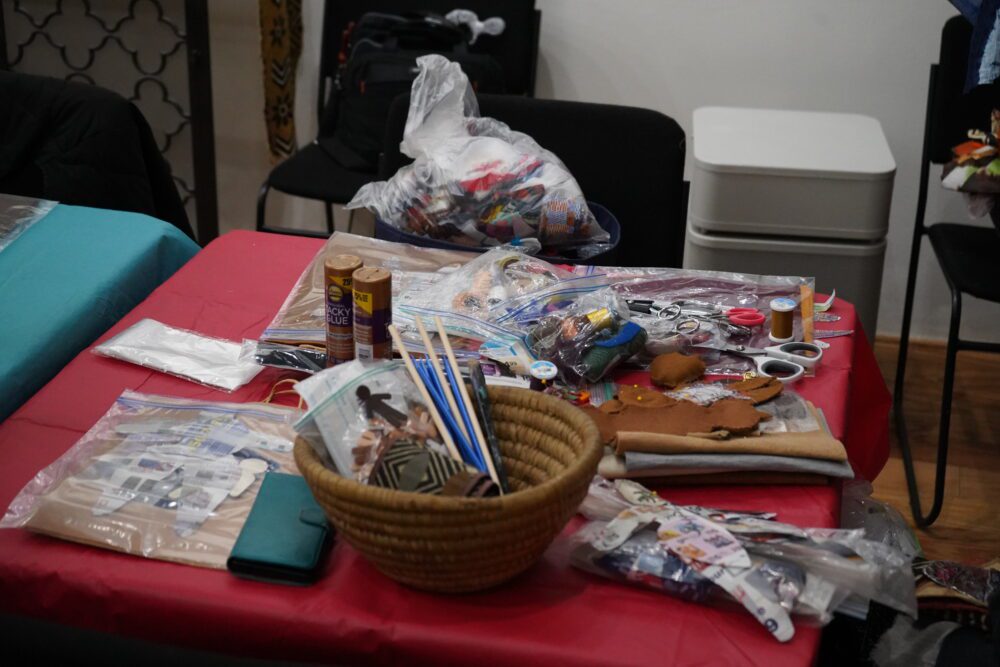
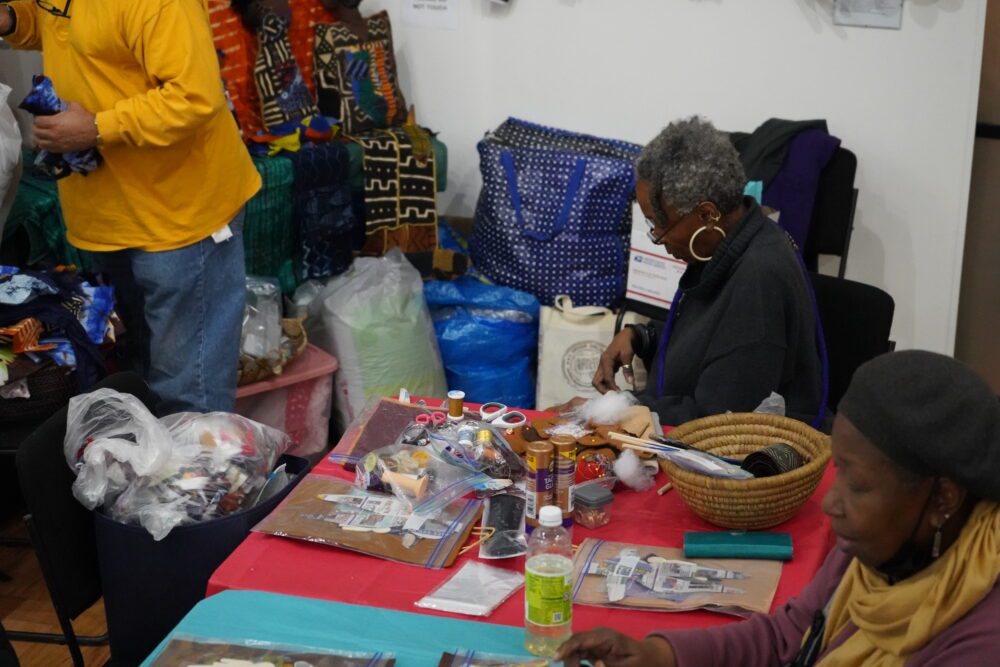
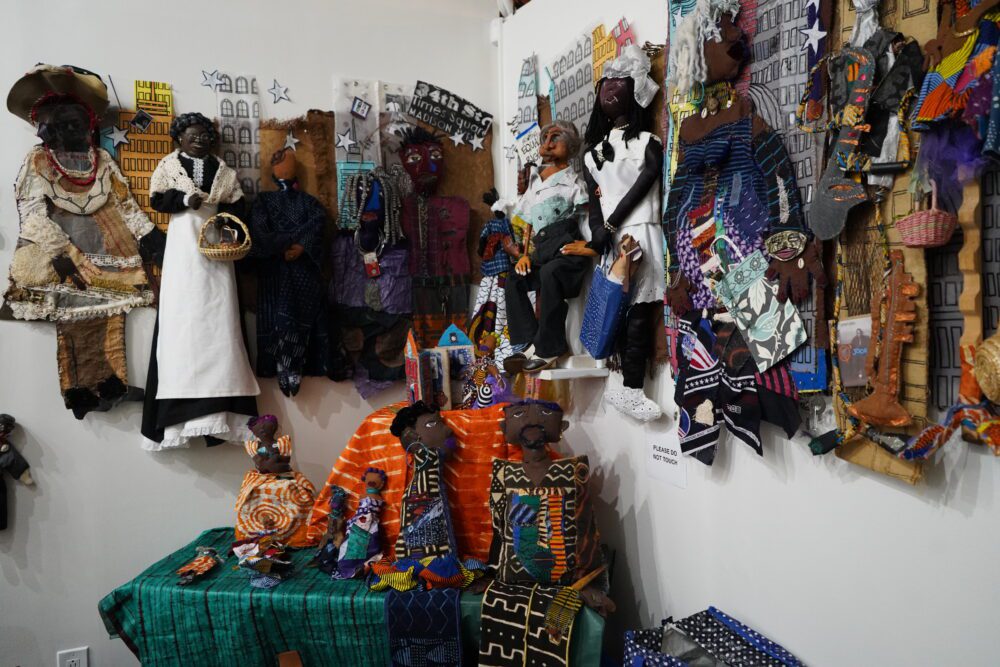
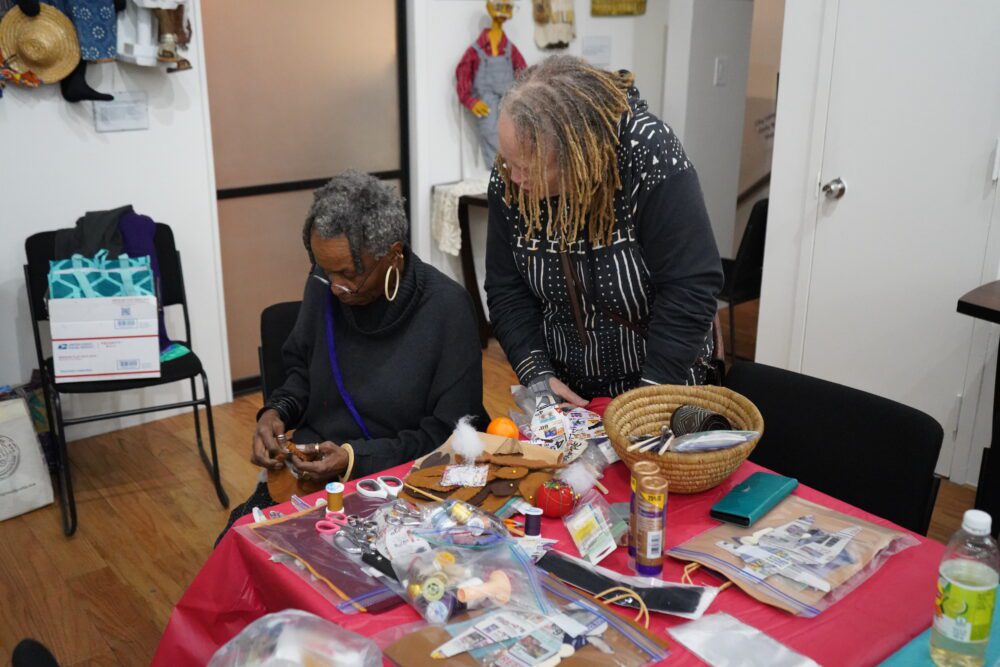
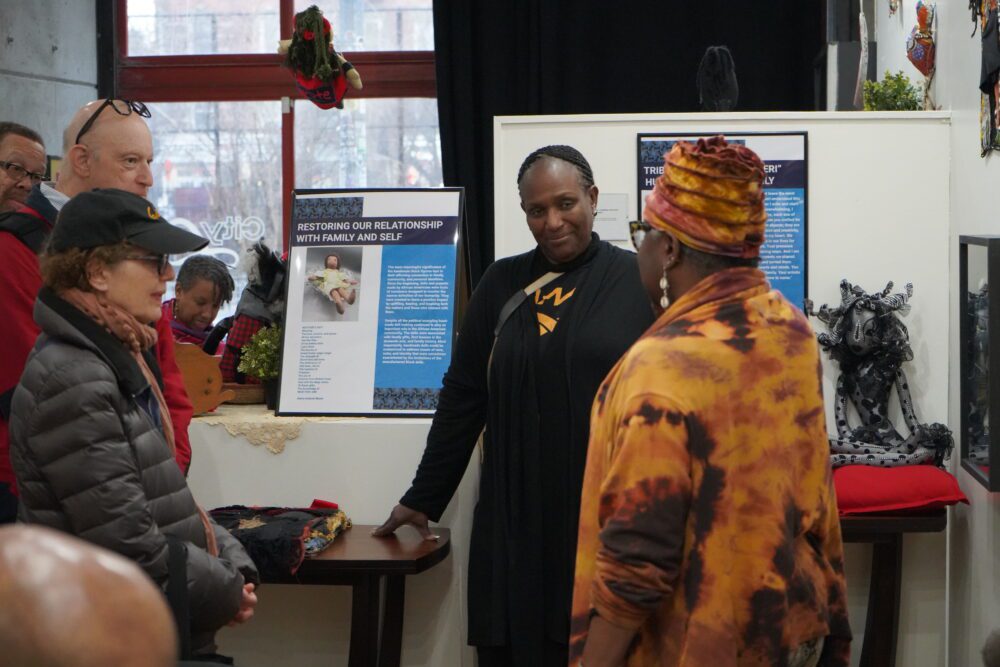

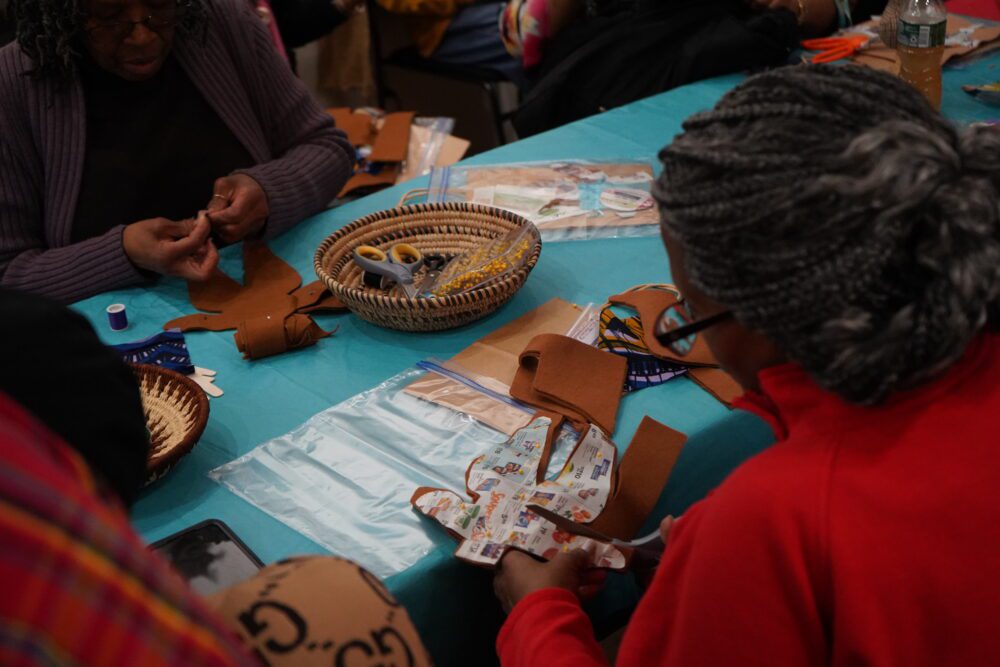
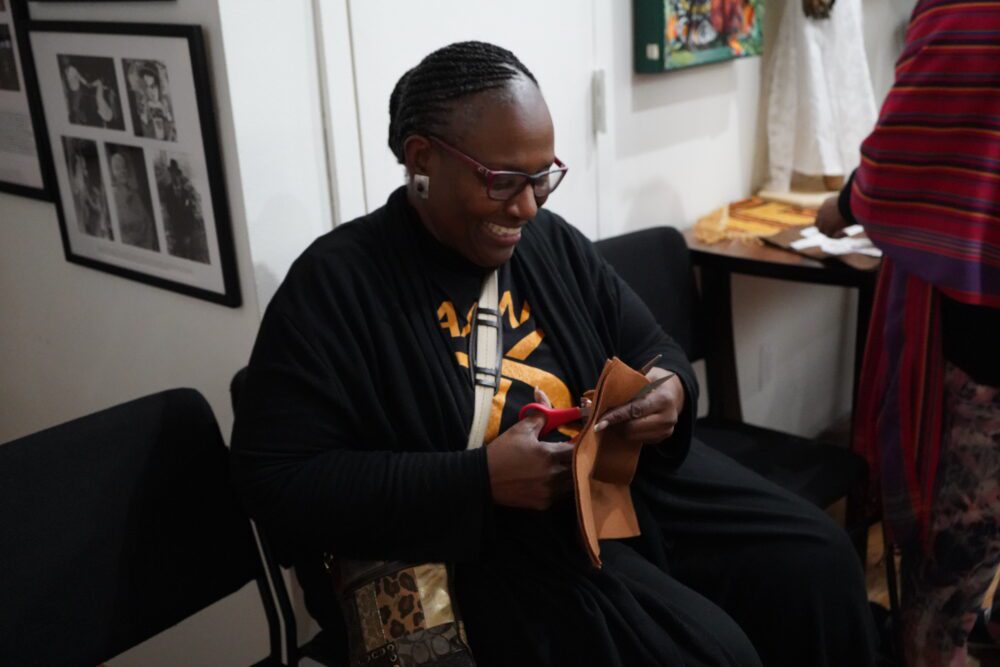
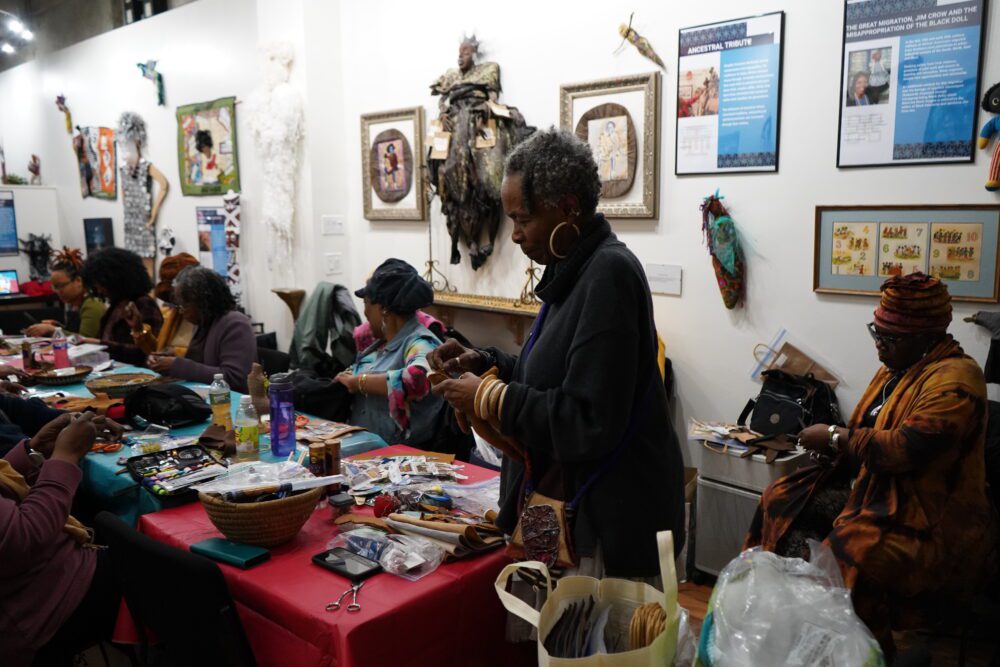

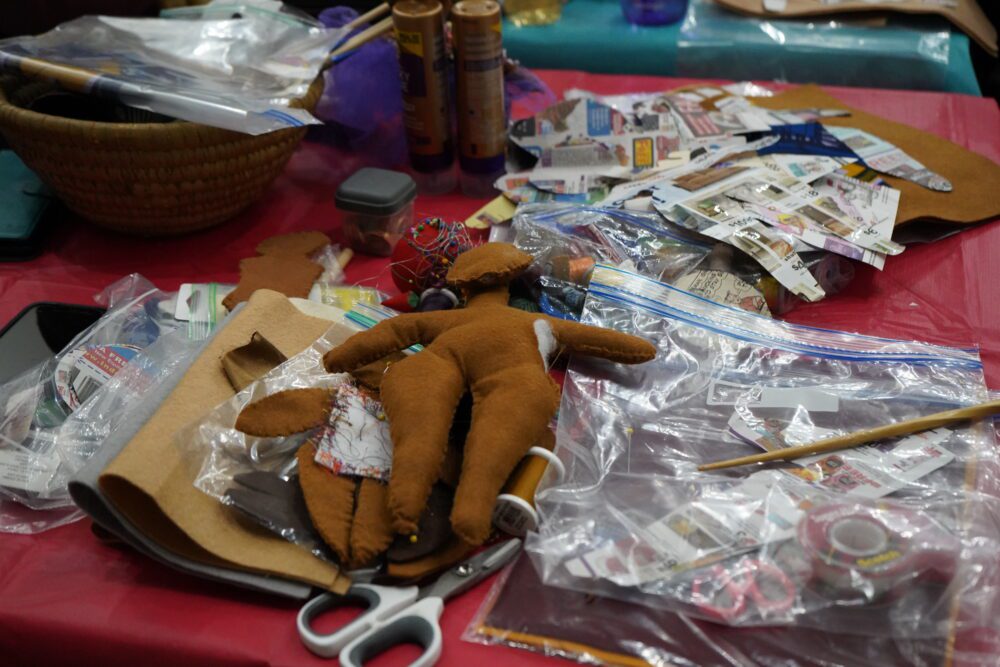


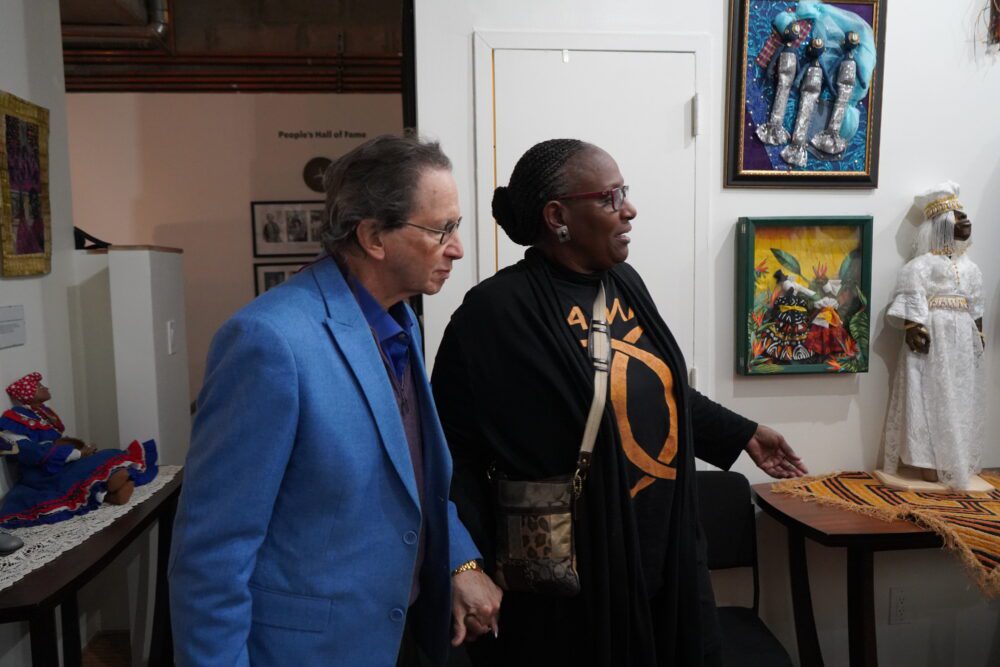
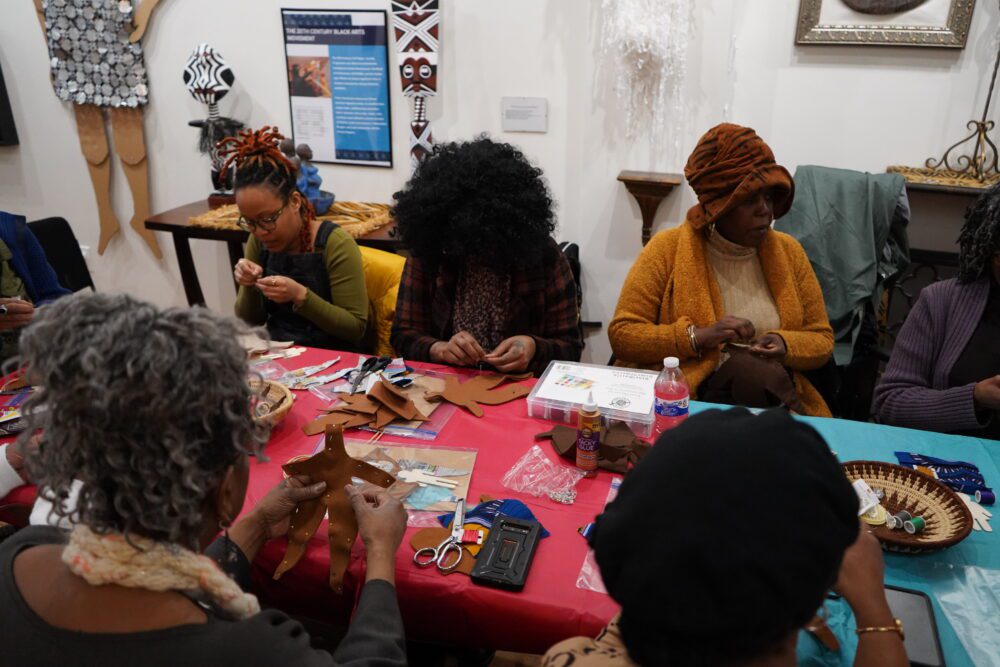
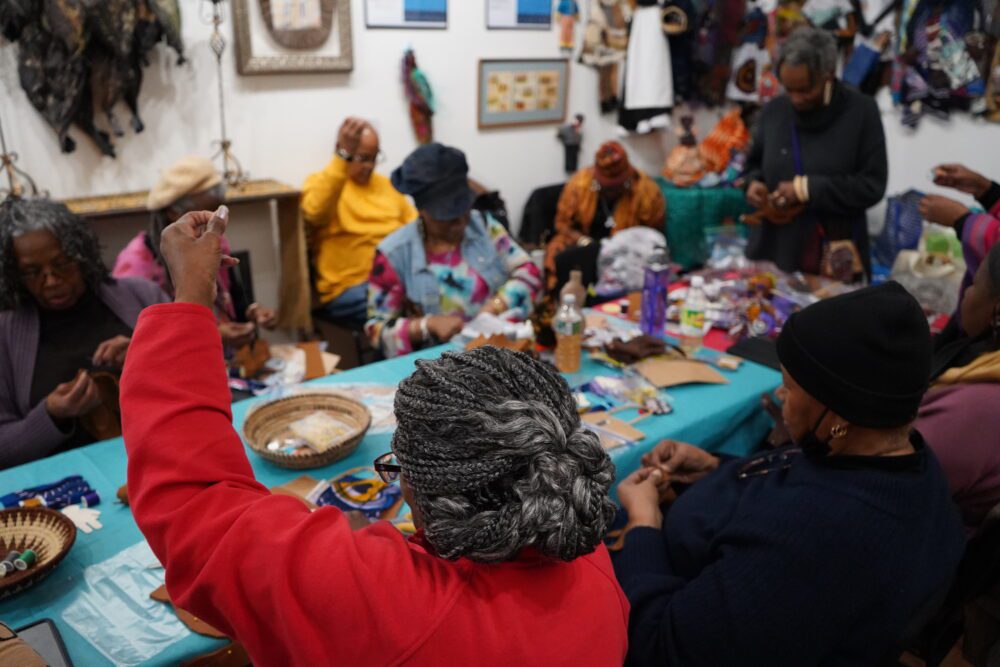


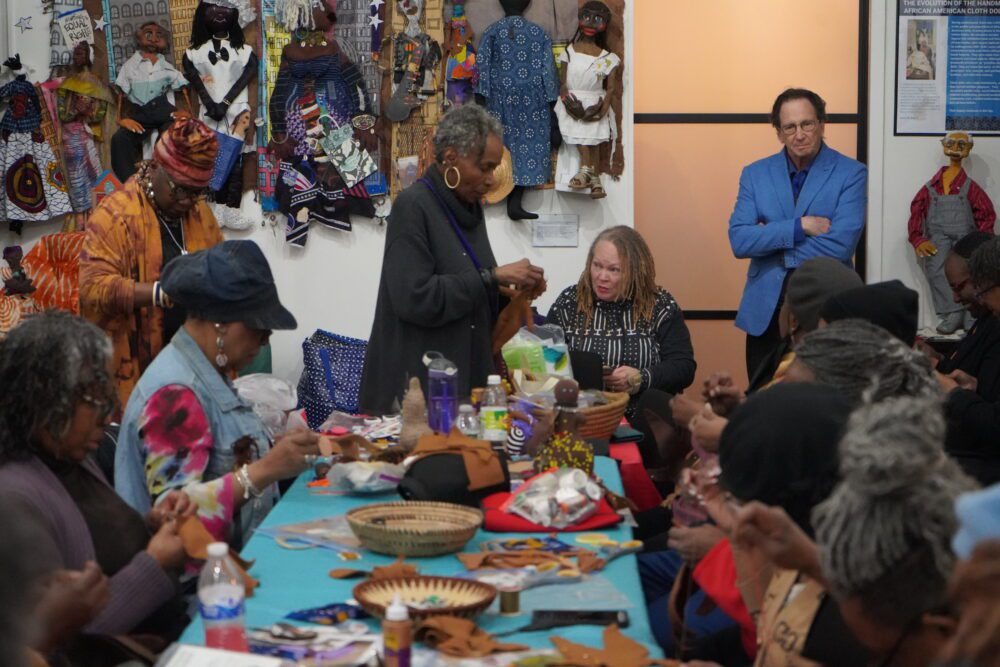


Doll Making: A Healing Art for Adults with Francine Haskins
Saturday, March 2, 2024
Renowned doll maker, Francine Haskins, lead the culminating public program, “Doll Making: A Healing Art for Adults,” bringing to a close City Lore’s exhibition, “The Calling: The Transformative Power of African American Doll and Puppet Making.” Ms. Haskins, the linchpin of this exhibition, envisioned this workshop as a straightforward, therapeutic, and healing experience.
The workshop was crafted to unlock both the creativity and apprehension associated with art. “There are a lot of wonderful artists out there that don’t even realize that they are artists. It’s the way we were taught to think. Artists are just creatives who make stuff,’” says Ms. Haskins. The session was designed to encourage participants to tap into their creativity and explore a new understanding of themselves. “Think for yourself, be your natural self, whatever the situation,” Ms. Haskins reminds us, “You never know who you will meet and what you will learn along the way.”
About the Artist
 MULTIMEDIA FIBER ARTIST, BOOK ILLUSTRATOR, DOLL MAKER & ART EDUCATOR
MULTIMEDIA FIBER ARTIST, BOOK ILLUSTRATOR, DOLL MAKER & ART EDUCATOR
Francine Haskins, “the doll lady” is the linchpin of this exhibition. Her relationship with many of the artists in this exhibition date back decades. She is among the original members of 1800 Belmont Arts, one of the important Black arts collectives during the Golden Age of Black Arts. Ms. Haskins’ mixed media dolls and quilts and children’s books “I Remember 121” and “Things I Like About Grandma” are cherished by collectors such as Johnetta Coles and Maya Angelou. She is a resident artist at the National Museum of African American History and Culture. Her work is available at the NMAAHC gift shop and is now part of the Library of Congress’ Center for the Books Collection. In 2020 she exhibited in “Birth of 2020 Visions” at Robert Blackburn Printing Workshop Program on West 39th Street in New York City as part of a collective of senior Black artists responding to the pandemic, and the relentless murders of Black People through art. Ms. Haskins has taught doll making for both youth and seniors. Francine Haskins,The Center for the Books Library of Congress – www.centerforthebooks.org, Francine Haskins, www.Digdc.diclibrary.org, Nine Artist Nine Months Nine Perspectives, www.rbpmw.efanyc.org
Celebrate Black History Month
Civil Rights Children’s Crusade with Schroeder Cherry And His Puppets
Saturday, February 10, 2024
This Interactive family friendly puppet show by exhibiting artist and puppeteer Schroeder Cherry is part of “The Calling: The Transformative Power of African American Doll and Puppet Making.”
A young boy discovers that his strict grandfather went to jail as a child. What was that about? This 30 minute performance is narrated by a rod puppet who uses wooden cutouts to tell what he learns about the 1963 Civil Rights Children’s Crusade. The puppeteer is in full view, dressed in black. The show ends in a participatory chant with the audience. Appropriate for 4th grade to adults. Children must be accompanied by a parent or guardian.
About the Artist
 Dr. Schroeder Cherry, a Baltimore based artist, grew up in Washington, DC. He is an award-winning mixed media artist who captures scenes of African American life with his puppets and his assemblage/mixed media artistry. Recently featured on the PBS program Crafts in American, he is currently the curator of the James E. Lewis Museum of Art and teaches Museum Studies at Morgan State University. His highly sought after work is exhibited nationally. “Schroeder Cherry” – Fleckenstein Gallery.com -Schroeder Cherry’s puppets are created as part of a performing troupe. Although the characters do not represent any one particular real-life person, they are inspired by personality types found within the African diaspora. The puppets perform in original shows that range from fantasy, like “The Land of Primary Colors,” to historically based shows such as “Can You Spell Harlem?” “Tuskegee Airmen;” Underground Railroad, Not A Subway;” and “Civil Rights Children’s Crusade.” Occasionally the puppets perform in “puppet slams.” These are shows where a group of puppeteers take the stage back-to-back and perform for about five minutes each.
Dr. Schroeder Cherry, a Baltimore based artist, grew up in Washington, DC. He is an award-winning mixed media artist who captures scenes of African American life with his puppets and his assemblage/mixed media artistry. Recently featured on the PBS program Crafts in American, he is currently the curator of the James E. Lewis Museum of Art and teaches Museum Studies at Morgan State University. His highly sought after work is exhibited nationally. “Schroeder Cherry” – Fleckenstein Gallery.com -Schroeder Cherry’s puppets are created as part of a performing troupe. Although the characters do not represent any one particular real-life person, they are inspired by personality types found within the African diaspora. The puppets perform in original shows that range from fantasy, like “The Land of Primary Colors,” to historically based shows such as “Can You Spell Harlem?” “Tuskegee Airmen;” Underground Railroad, Not A Subway;” and “Civil Rights Children’s Crusade.” Occasionally the puppets perform in “puppet slams.” These are shows where a group of puppeteers take the stage back-to-back and perform for about five minutes each.
Conversations with African American Doll & Puppet Makers about Spirituality, Creativity, and their Callings as Artists
Stay tuned for a video recording of the program!
January 16th, 2024
City Lore, an Affiliate of the Smithsonian, is pleased to present a Zoom session featuring conversations about the transformative power of spirituality in the doll and puppet making processes. The presentation and discussion featured a number of African American doll and puppet makers featured in the current exhibition, “The Calling: The Transformative Power of African American Doll and Puppet Making.”
Emphasizing several orientations and perspectives on spirituality across their work, this conversation examined the artists’ callings to create dolls and puppets, and the ways their creations have offered transformative power for themselves and the betterment of the communities in which they live. Serving as moderator was the exhibit’s scholar, Dr. Phyllis M. May-Machunda, PhD., who also co-edited the exhibit’s accompanying book.
Participating Artists Include:
- Camila Bryce-Laporte
- Elaine Robnett Moore
- Francine Haskins
- Paulette Richards
- Yolanda Sampson
- IBe’ Crawley
- Shimoda Donna Emanuel
- Judy Boldon Bain

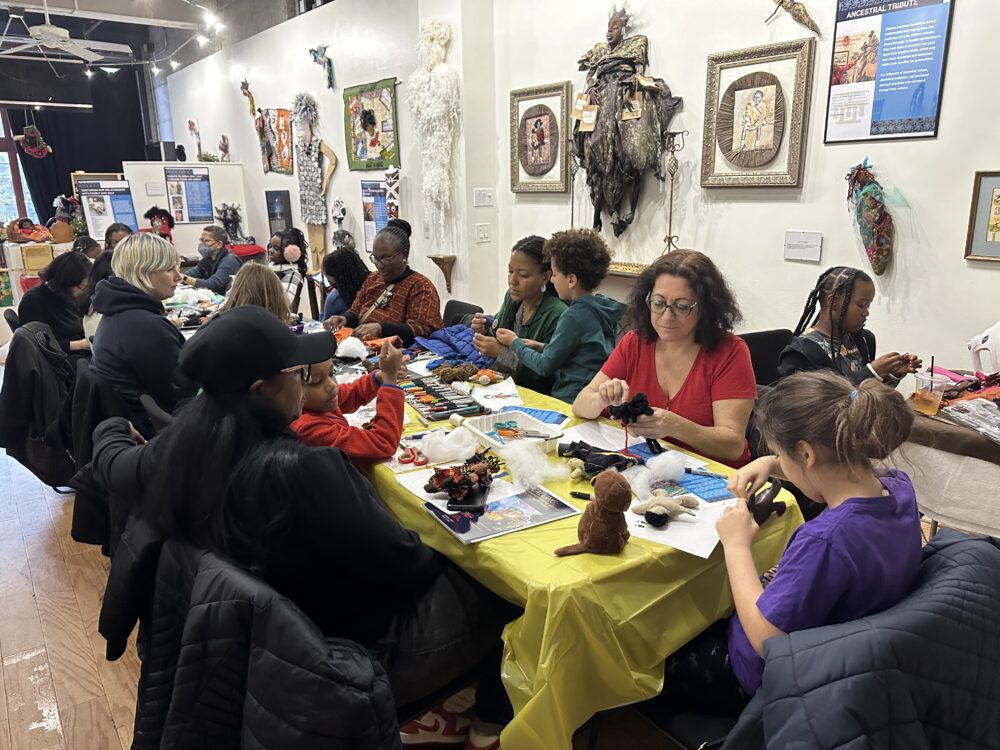


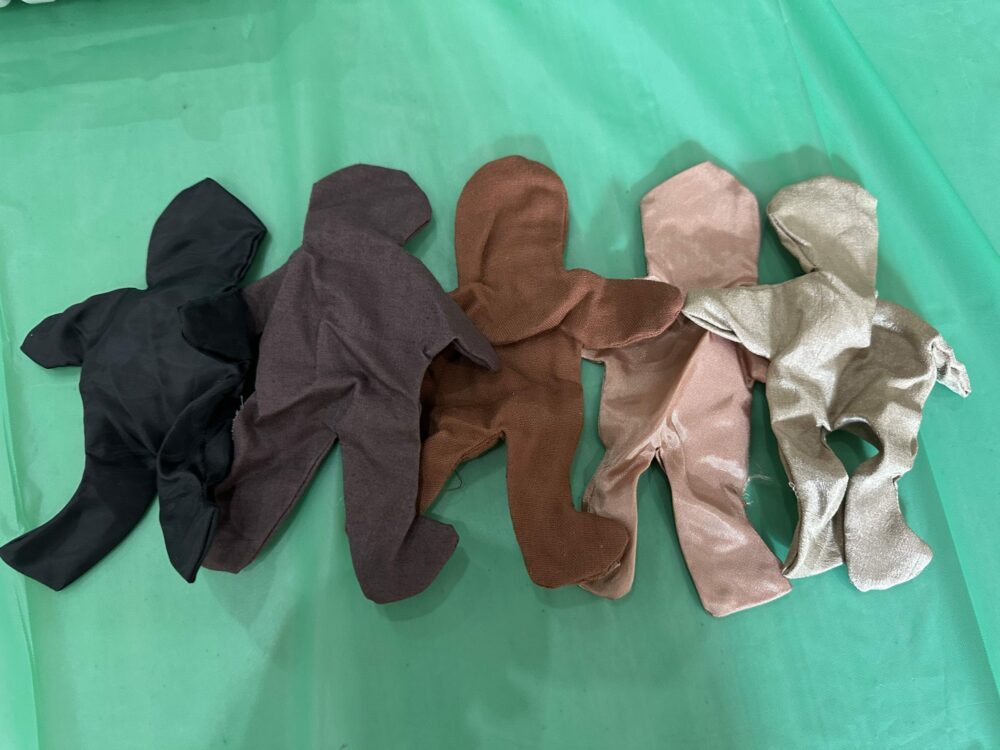
Brown Spices Elves Doll Making Workshop with Julee Dickerson Thompson
November 18th, 2023
An interactive family friendly doll making workshop for children ages 6-12. Participants learned how to make “Brown Spice Miniatures,” or small hand sewn cloth dolls representative of Dickerson-Thompson’s signature inclusive aesthetic that is an homage to children and families of the African Diaspora. For over four decades, Dickerson-Thompson has been steadily building a family of dolls, accessories, and educational materials that speak to the diversity of Black experience in the United States and beyond. She regularly offers Brown Spice Elves Workshops (mini doll making) as a component of her Young Masters (YM) curriculum and programming. A celebrated arts educator, these workshops are as much about family storytelling as they are hand craft creation.
About the Curator – Camila Bryce-LaPorte is a folklife specialist and community scholar who works with people to help them rediscover the value of their history, their cultural traditions, their community, and themselves through the art of cultural documentation. She trains people to capture and preserve the history of and traditions of their community and their culture bearers. Bryce-LaPorte has worked on folklife-related projects for the Smithsonian Center for Folklife and Cultural Heritage, the American Folklife Center at the Library of Congress, City Lore, and Ujamaa Cooperative Farming Alliance.
About the Scholar – Dr. Phyllis M. May-Machunda is a folklorist/ethnomusicologist who has spent her career researching and bringing attention to absent narratives from communities of color. Prior to teaching for 30 years in Minnesota, she was employed as a folklorist/curator in Smithsonian’s Office of Folklife Programs and as a researcher for Smithsonian’s Program in Black American Culture. Earning her MA and Ph.D. from Indiana University’s Dept of Folklore, she is curator of several multicultural exhibitions, including the online Notable Folklorists of Color for the American Folklore Society (2019, 2022), and author of numerous articles. May-Machunda is editor of the book accompanying this exhibition for City Lore Gallery.
About City Lore Gallery – The City Lore Gallery is a cultural hub that celebrates New York City’s vibrant cultural atmosphere and provides a platform for the myriad voices that comprise the City. The gallery presents exhibitions and events on all the things that make New York “New York.” From the golden age of graffiti, to endangered languages and activist comics, City Lore finds the art in everyday life. City Lore works in four cultural domains—urban folklore and history, preservation, arts education and grassroots poetry traditions—and is committed to the principles of cultural equity and democracy.
About City Lore – Founded in 1986, and now an Affiliate of the Smithsonian Institution, City Lore’s mission is to foster New York City – and America’s – living cultural heritage through education and public programs. We document, present, and advocate for New York City’s grassroots cultures to ensure their living legacy in stories and histories, places and traditions. We work in four cultural domains: urban folklore and history; preservation; arts education; and grassroots poetry traditions. In each of these realms, we see ourselves as furthering cultural equity and modeling a better world with projects as dynamic and diverse as New York City itself. For more info: http://www.citylore.org.
City Lore is made possible with generous support from: Institute of Museum and Library Services, New York State Council on the Arts. New York City Department of Cultural Affairs, The Sherman Foundation, Lily Auchincloss Foundation
On view at City Lore Gallery [56 E. 1st Street] from October 6th, 2023 through March 2, 2024





